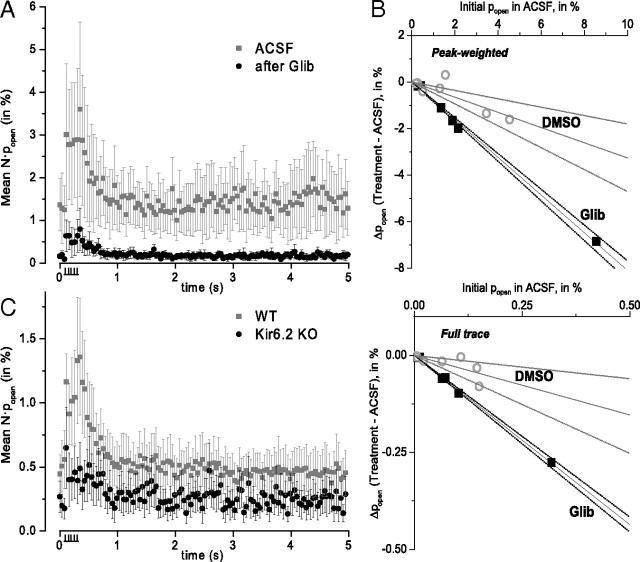Figure 3.
Both the firing-induced and basal channel openings are mainly KATP channels. A, Average effect of glibenclamide wash-in on channel open probability after recording of baseline activity in ACSF. The KATP blocking drug glibenclamide (100 nm) attenuates the spike-elevated opening of channels compared with paired five-stimulus trials recorded in ACSF alone. Mean ± SEM; n = 6. B, Estimate of the fractional blockade by glibenclamide. Δpopen (final − initial) is plotted against the initial popen (in ACSF), with each symbol representing a separate experiment with glibenclamide (black squares) or DMSO (gray circles) wash-in. Linear fits through the origin, for each dataset, represent a fixed fractional reduction in current produced by the blocker. The two graphs use different time samples: full-trace effects (bottom) simply used the full-trace average popen, while peak-weighted effects (top) were weighted with a function that was constant during the stimulus interval and decayed with a time constant of 0.3 s thereafter. Dotted lines mark the 95% confidence limits for the linear fits. For glibenclamide, the fitted slopes were (peak) −0.81 ± 0.02 and (full) −0.87 ± 0.02, consistent with ∼80–90% inhibition. For DMSO, the fitted slopes were (peak) −0.33 ± 0.06 and (full) −0.31 ± 0.08 (n = 7). C, Channel activity is reduced in DGNs from Kir6.2 knock-out mice. Summary for experiments with five-stimuli in wild-type animals (gray symbols, mean ± SEM, n = 35), and Kir6.2−/− (black symbols, mean ± SEM, n = 11). Most experiments were performed and analyzed blind to genotype.

